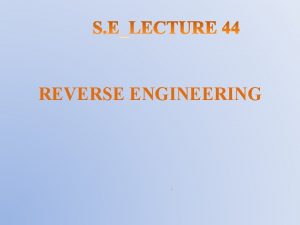REVERSE ENGINEERING PROJECT PART 1 DUE 5162020 REVERSE




- Slides: 4

REVERSE ENGINEERING PROJECT PART 1 – DUE 5/16/2020

(REVERSE ENGINEERING ITEM) Full Name / Class Period Item Selection Select an object to Reverse Engineering that meets the following criteria: • Composed of 3 -10 individual parts • All component parts are visible OR the item can be easily taken apart without damaging anything. (Ideally the object does not include a motor or electronic components. ) • The item could be enhanced, improved, or made better somehow. Item Documentation • • Use a camera to take at least 2 photos images of the front, top or the side view of your product. If you do not have a camera, you can sketch them or Google the product. Add at least 2 images, label the view and write a description using the visual elements & principles. The last slide is a summary of the Elements and Principles for your reference. Add description of the visual elements and principles of design that are evident from this particular view. (view type) Add description of the visual elements and principles of design that are evident from this particular view. Suggestions for household items appropriate for the reverse engineering project: • Office/Rec. Room/Playroom: Mechanical pencil, Baby/Toddler toy, Happy Meal Toys, Side/Accent/coffee table, Bookshelf, Staple remover, Picture frame, Hand pencil sharpener with storage container (not electric) • Garage/Outside: Garden tools (Pruning shears, wheelbarrow, rake), Umbrella, Bicycle pedal, Bicycle basket, Badminton/ Tennis racket, Lawn Chair, Wall mounted garden tool organizer, Bird Feeder, Shop tool (Level, wire stripper, adjustable wrench, etc) • Kitchen: Dish brush, Insulated drink container with lid, Garlic press, Manual orange juice press, Ice cream scoop with lever, Salad tongs, Manual can opener • Bedroom/bathroom: Knick knack box with hinges, Hair barrette, Jewelry stand, Lint roller, Drawer

(REVERSE ENGINEERING ITEM) Full Name / Class Period VISUAL ANALYSIS – Principles and Elements Matrix 1. Learn how the Elements and Principles are used in product design by reading through the Power. Point or watching the videos: • Power. Point: 6. 1 Visual Elements & Principles PPT • Videos: Elements of Design Part 1 (9: 25), Elements of Design Part 2 (8: 15), 6 Design Principles (4: 00) 2. Complete the table below for your Reverse Engineering item. Fill out the first row with a brief description of each element. (Example: For Color- Warm brown and beige earth-tones) • Then fill out at least one box from each row & column. • The next slide is a summary of the Elements and Principles for your reference. Line Description of Element Balance Emphasis Contrast Rhythm Proportion Unity Color Value Shape Form Space Texture

Elements of Design Summary Balance Line • • Principles of Design Summary Vertical- Represents dignity, formality, stability and strength. Horizontal- Represents calm, peace and relaxation. Diagonal- Represents action, activity, excitement and movement. Curved- Represents freedom, the natural, having the appearance of softness and creates a soothing feeling or mood. Color • Color has an immediate and profound effect on a design. • Warm Colors - Reds, oranges, yellows • Cool Colors - Blues, purples, greens • Colors can affect how humans feel and act. Form and Shape • The shape, outline, or configuration of anything. Examples: Squares, Circles, Ellipses, Ovals, Rectangles, Triangles • • • Parts of the design are equally distributed to create a sense of stability. Symmetrical or Formal Balance - The elements within the design are identical in relation to a centerline or axis. Asymmetrical or Informal Balance - Parts of the design are not identical but are equal in visual weight. Radial Balance - Design Elements radiate outward from the center. Vertical Balance - The top and bottom parts are equal. Horizontal Balance - The parts on left and right are equal. Rhythm • • • Repeated use of line, shape, color, texture or pattern. Regular rhythm - An element is repeated at the same repetition/interval each time. Graduated rhythm - The beats of element become closer or further apart as they move. Random rhythm - The beats of element are random or at irregular intervals. Gradated rhythm - The repeated element is identical with the exception of one detail increasing or decreasing gradually with each repetition. Emphasis Space • Organization of space in a design can enlarge or reduce the visual space. • Open, uncluttered spaces, cramped, or busy • Unused vs. good use of space • • • Texture • The surface look or feel of something. • Smooth surface - Reflects more light; a more intense color. • Rough surface - Absorbs more light; appears darker. Proportion and Scale • Comparative relationships between elements with respect to size. • 3: 5 ratio is known as the Golden Mean. • The proportions or size of one part of the image in relationship to the other. Value • The relative lightness or darkness of a color. • Shade - Degree of darkness of a color • Tint - A pale or faint variation of a color Points of attention in a design. The feature in a design that attracts one’s eye. The focal point. Emphasis can be achieved through size, placement, color and use of lines. The most personal aspect of a design. Unity • • Unity is applying consistent use of lines, color, and texture within a design. To be harmonious.







